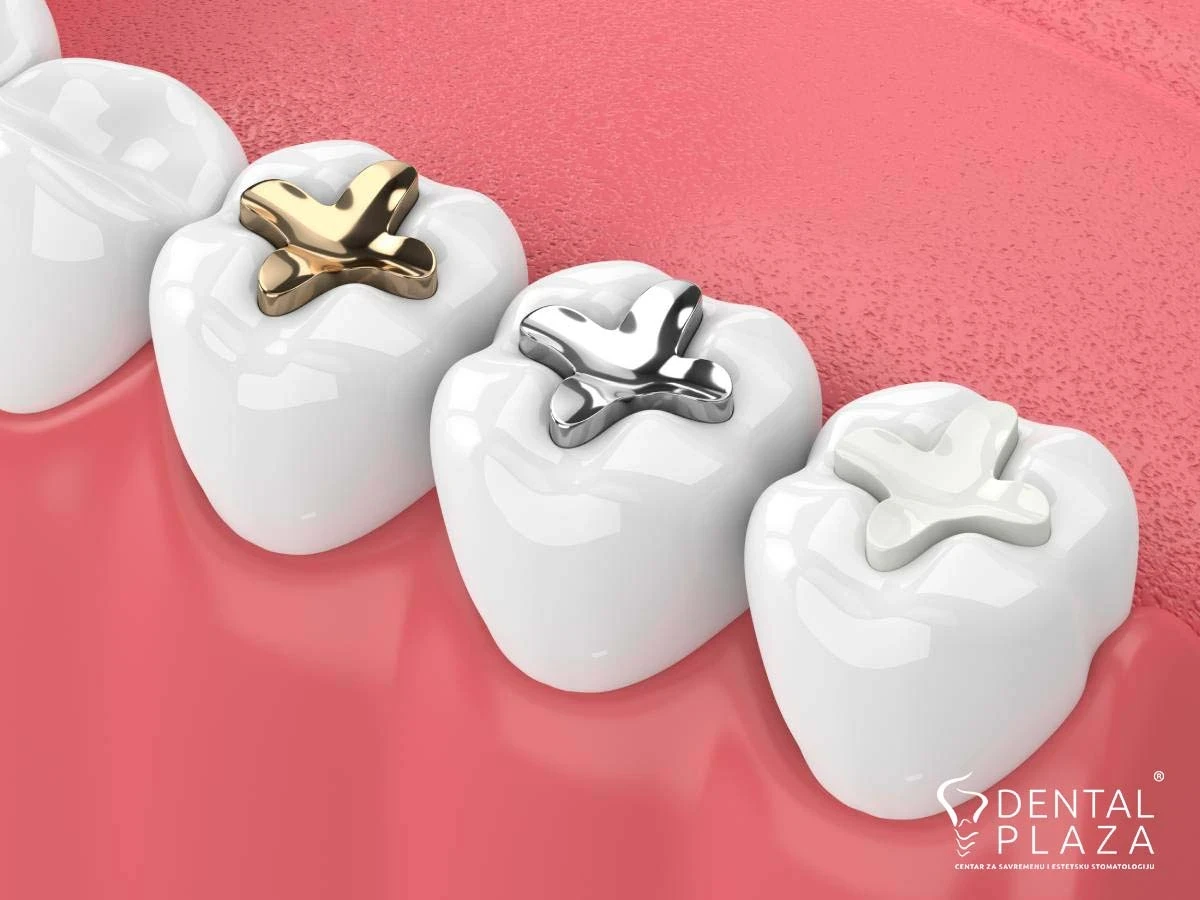Do not be shy, show your teeth!
Call Center 08-21h
Do not be shy, show your teeth!
Call Center 08-21h

Gold fillings are specific prosthetic fillings, often called indirect fillings (sealings). They serve as fillings in cases where caries has destroyed the crown of the tooth too much and when, after caries removal, the resulting cavity cannot be satisfactorily compensated with a classic filling (either amalgam or composite), then these restorations can be made. They have exceptional characteristics, because gold is a precious metal. It does not corrode and is completely biocompatible, so it does not irritate neighboring tissues. Gold fillings include gold inlays (indirect filling on a small part of the biting surface of the tooth), gold onlays (gold fillings that include the tip of the tooth).
Gold fillings, as the name suggests, are made of high-quality gold. Thanks to modern production technology and exceptional characteristics of gold, these types of fillings have excellent characteristics.
Unlike classic fillings that are made and modeled in the mouth from composite materials, gold Inlay, Onlay and Overlay are made using a technique based on an impression of an already prepared tooth.
When a large part of the dental tissue is damaged, it is not recommended to compensate it with composite fillings, but in such situations it is preferable to use a stronger and more resistant material. Previously, teeth with large fillings were placed under the crown, however, new technologies and modern manufacturing methods have enabled and facilitated the process of making ceramic or gold fillings. Gold fillings ensure that the damaged tooth is treated with as little removal as possible of the remaining healthy tooth tissue.
Also, a significant advantage is the excellent edge adhesion and perfect polishing of gold fillings. A good fit to the tooth of any kind of dental restoration reduces the possibility that cavities will occur again due to the entry and retention of food and bacteria. That is why the edge of the gold seal is made extremely precisely. Also, the surface of the gold filling is perfectly polished, and thus is not susceptible to the accumulation of dental plaque, thus reducing the possibility of caries.
Over the years, with composite fillings, the formation of microcracks at the joint with the tooth may occur, and thus the marginal adhesion may weaken. Gold fillings are dimensionally stable and provide greater durability.
Depending on the surface of the tooth they replace, the replacements have different names: inley, onley and overlay. For any of these restorations, it is necessary to prepare the tooth. The procedure takes very little time. After tooth preparation, which includes caries removal, an impression is taken using an intraoral scanner, very quickly and comfortably. Another option is to take a conventional impression on which a gold restoration will be made later.

In the technique, the future restoration is manually modeled in wax, and then the restoration is casted from a block of gold. When the design and fabrication of the gold restoration is completed, the final processing of the indirect filling is performed. The shape of the made restoration fits perfectly with the rest of the tooth that is being replaced, and with the rest of the teeth when biting.
Gold fillings are usually made in one or two visits to the dentist. In cases where the tooth on which a gold filling is performed requires dental treatment, then the number of visits increases.
In the first visit, the cavity is cleaned and the tooth is prepared for the restoration. In the same visit, an impression is taken for further processing. Already in the second visit, the gold filling is tried how it fits and its fixation is carried out if there are conditions for it.

The duration of gold fillings depends on several factors and will depend on whether all procedures were followed during its installation. The longevity of the replacement itself depends on the quality of the material from which it is made. Since gold is a high-quality precious metal, it is clear that gold fillings are extremely long-lasting and high-quality restorations. Also, the size of the restoration on the tooth, as well as its fit into the occlusion (bite) can affect the service life. Gold fillings that compensate for large areas of teeth are more prone to cracking.

Do you have questions?

Gold fillings are specific prosthetic fillings, often called indirect fillings (sealings). They serve as fillings in cases where caries has destroyed the crown of the tooth too much and when, after caries removal, the resulting cavity cannot be satisfactorily compensated with a classic filling (either amalgam or composite), then these restorations can be made. They have exceptional characteristics, because gold is a precious metal. It does not corrode and is completely biocompatible, so it does not irritate neighboring tissues. Gold fillings include gold inlays (indirect filling on a small part of the biting surface of the tooth), gold onlays (gold fillings that include the tip of the tooth).
Gold fillings, as the name suggests, are made of high-quality gold. Thanks to modern production technology and exceptional characteristics of gold, these types of fillings have excellent characteristics.
Unlike classic fillings that are made and modeled in the mouth from composite materials, gold Inlay, Onlay and Overlay are made using a technique based on an impression of an already prepared tooth.
When a large part of the dental tissue is damaged, it is not recommended to compensate it with composite fillings, but in such situations it is preferable to use a stronger and more resistant material. Previously, teeth with large fillings were placed under the crown, however, new technologies and modern manufacturing methods have enabled and facilitated the process of making ceramic or gold fillings. Gold fillings ensure that the damaged tooth is treated with as little removal as possible of the remaining healthy tooth tissue.
Also, a significant advantage is the excellent edge adhesion and perfect polishing of gold fillings. A good fit to the tooth of any kind of dental restoration reduces the possibility that cavities will occur again due to the entry and retention of food and bacteria. That is why the edge of the gold seal is made extremely precisely. Also, the surface of the gold filling is perfectly polished, and thus is not susceptible to the accumulation of dental plaque, thus reducing the possibility of caries.
Over the years, with composite fillings, the formation of microcracks at the joint with the tooth may occur, and thus the marginal adhesion may weaken. Gold fillings are dimensionally stable and provide greater durability.
Depending on the surface of the tooth they replace, the replacements have different names: inley, onley and overlay. For any of these restorations, it is necessary to prepare the tooth. The procedure takes very little time. After tooth preparation, which includes caries removal, an impression is taken using an intraoral scanner, very quickly and comfortably. Another option is to take a conventional impression on which a gold restoration will be made later.

In the technique, the future restoration is manually modeled in wax, and then the restoration is casted from a block of gold. When the design and fabrication of the gold restoration is completed, the final processing of the indirect filling is performed. The shape of the made restoration fits perfectly with the rest of the tooth that is being replaced, and with the rest of the teeth when biting.
Gold fillings are usually made in one or two visits to the dentist. In cases where the tooth on which a gold filling is performed requires dental treatment, then the number of visits increases.
In the first visit, the cavity is cleaned and the tooth is prepared for the restoration. In the same visit, an impression is taken for further processing. Already in the second visit, the gold filling is tried how it fits and its fixation is carried out if there are conditions for it.

The duration of gold fillings depends on several factors and will depend on whether all procedures were followed during its installation. The longevity of the replacement itself depends on the quality of the material from which it is made. Since gold is a high-quality precious metal, it is clear that gold fillings are extremely long-lasting and high-quality restorations. Also, the size of the restoration on the tooth, as well as its fit into the occlusion (bite) can affect the service life. Gold fillings that compensate for large areas of teeth are more prone to cracking.
